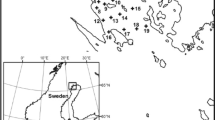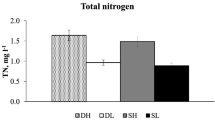Abstract
Concentration of dissolved DNA, microbial biomass, and consumption of bacteria by heterotrophic nanoflagellates (HNF) and ciliates were examined in a hypereutrophic pond for over 7 months to elucidate the main factors which influenced the release of dissolved DNA. Changes in concentration of dissolved DNA correlated well with both abundance of ciliates ( r = 0.788, p < 0.01) and rotifers ( r = 0.738, p < 0.01). A significant correlation was also found between dissolved DNA concentration and ciliate community ingestion rates ( r = 0.668, p <0.01). These results suggest that consumption of bacteria by ciliates is an important reason for the release of dissolved DNA.
Similar content being viewed by others
References
Bailiff, M. D. & D. M. Karl, 1991. Dissolved and particulate DNA dynamics during a spring bloom in the Antarctic Peninsula region, 1986–87. Deep Sea Res. 38: 1077–1095.
Caron, D. A., 1983. Technique for enumeration of heterotrophic and phototrophic nanoplankton, using epifluorescence microscopy, and comparison with other procedures. Appl. envir. Microbiol. 46: 491–498.
Christen, A. A., M. L. Paul, T. Manzara & P. F. Lurquin, 1983. Rapid isolation of Escherichia coli by glass-fiber minicell filtration: study of plasmid-coded polypeptides. Gene. 23: 195–198.
DeFlaun, M. F., J. H. Paul & D. Davis, 1986. Simplified method for dissolved DNA determination in aquatic environments. Appl. envir. Microbiol. 52: 654–659.
DeFlaun, M. F., J. H. Paul & W. H. Jeffrey, 1987. Distribution and molecular weight of dissolved DNA in subtropical estuarine and oceanic environments. Mar. Ecol. Prog. Ser. 38: 65–73.
Jørgensen, N. O. & C. S. Jacobsen, 1996. Bacterial uptake and utilization of dissolved DNA. Aquat. Microb. Ecol. 11: 263–270.
Karl, D. M. & M. D. Bailiff, 1989. The measurement and distribution of dissolved nucleic acids in aquatic environments. Limnol. Oceanogr. 34: 543–558.
Kawabata, Z., N. Ishii, M. Nasu & M.-G. Min, 1998. Dissolved DNA produced through a prey–predator relationship in a species-defined aquatic microcosm. Hydrobiologia, in press.
Miner, R. A., 1972. Characterization of naturally occurring dissolved organophosphorus compounds. Envir. Sci. Technol. 6: 431–437.
Nagata, T. & D. L. Kirchman, 1992a. Release of dissolved organic matter by heterotrophic protozoa: Implications for microbial food webs. Arch. Hydrobiol., Beih. Ergeb. Limnol. 35: 99–109.
Nagata, T. & D. L. Kirchman, 1992b. Release of macromolecular organic complexesby heterotrophic marine flagellates. Mar. Ecol. Prog. Ser. 83: 233–240.
Paul, J. H., W. H. Jeffrey & M. F. DeFlaun, 1987. Dynamics of extracellular DNA in the marine environment. Appl. envir. Microbiol. 53: 170–179.
Paul, J. H., M. F. DeFlaun, W. H. Jeffrey & A. W. David, 1988. Seasonal and diel variability in dissolved DNA and in microbial biomass and activity in subtropical estuary. Appl. envir. Microbiol. 54: 718–727.
Paul, J. H. & A. W. David, 1989. Production of extracellular nucleic acids by genetically altered bacteria in aquatic-environment microcosms. Appl. envir. Microbiol. 55: 1865–1869.
Paul, J. H., L. Cazares & J. Thurmond, 1990a. Amplification of rbcL gene from dissolved and particulate DNA from aquatic environments. Appl. envir. Microbiol. 56: 1963–1966.
Paul, J. H., W. H. Jeffrey & J. P. Cannon, 1990b. Production of dissolved DNA, RNA, and protein by microbial population in Florida Reservoir. Appl. envir. Microbiol. 56: 2957–2962.
Paul, J. H., M. E. Frischer & J. M. Thurmond, 1991a. Gene transfer in marine water column and sediment microcosms by natural plasmid transformation. Appl. envir. Microbiol. 57: 1509–1515.
Paul, J. H., S. C. Jiang & J. B. Rose, 1991b. Concentration of viruses and dissolved DNA from aquatic environment by vortex flow filtration. Appl. envir. Microbiol. 57: 2197–2204.
Pillai, T. N. V. & A. K. Ganguly, 1972. Nucleic acid in the dissolved constituents of sea water. J. mar. biol. Ass. India 14: 1–7.
Porter, K. G. & Y. S. Feig, 1980. The use of DAPI for identifying and counting aquatic microflora. Limnol. Oceanogr. 25: 943–948.
Rami, M. & D. Porath, 1980. Chlorophyll determination in intact tissues using N, N-dimethylformamide. Plant. Physiol. 65: 478– 479.
Reanny, D. C., P. C. Gowland & J. H. Slater, 1983. Genetic interactions among communities. In R. W. J. H. Slater & J. W. T. Wimpenny (eds), Microbes in the Natural Environment. Cambridge University Press, Cambridge: 379–421.
Sanders, R. W., K. G. Porter, S. J. Bennett & A. E. Debiase, 1989. Seasonal patterns of bacterivory by flagellates, ciliates, rotifers, and cladocerans in a freshwater planctonic community. Limnol. Oceanogr. 34: 673–387.
Sherr, B. F., E. B. Sherr & R. D. Fallon, 1987. Use of monodispersed, fluorescently labeled bacteria to estimate in situ protozoan bacterivory. Appl. envir. Microbiol. 53: 958–965.
Takamura, N., Y. Ishikawa, H. Mikami, H. Mikami, Y. Fujita, S. Higuchi, H. Murase, S. Yamanaka, Y. Nan-Jyo, T. Igari & T. Fukushima, 1996. Abundance of bacteria, picoplankton, nanoflagellates and ciliates in relation to chlorophyll α and nutrient concentrations in 34 Japanese waters. Jpn. J. Limnol. 57: 245–259 (in Japanese).
Turk, V., A.S. Rehnstam, E. Lundberg & Å. Hagström, 1992. Release of bacterial DNA by marine nanoflagellates, an intermediate step in phosphorus regeneration. Appl. envir. Microbiol. 58: 3744–3950.
Ueda, S. & T. Hara, 1981. Studies on nucleic acid production and application. I. Production of extracellular DNA by Pseudomonas sp. KYU-1. J. Appl. Biochem. 3: 1–10.
Watson, J. D., N. H. Hopkins, J. W. Roberts, J. A. Steitz & A. M. Weiner, 1965. Cellular proteins can be displayed on two-dimensional gels, In: Molecular biology of the gene. The benjamin/cummings publishing company, Inc., California: 102.
Williams, H. G., M. J. Day, J. C. Fry & G. J. Stewart, 1996. Natural transformation in river epilithon. Appl. envir. Microbiol. 62: 2994–2998.
Author information
Authors and Affiliations
Rights and permissions
About this article
Cite this article
Ishii, N., Kawabata, Z., Nakano, Si. et al. Microbial interactions responsible for dissolved DNA production in a hypereutrophic pond. Hydrobiologia 380, 67–76 (1998). https://doi.org/10.1023/A:1003475000195
Issue Date:
DOI: https://doi.org/10.1023/A:1003475000195




